Overview
The article titled "10 Essential Java OOP Programs to Boost Your Coding Efficiency" addresses the common challenges developers face in coding. With the increasing complexity of projects, how can developers enhance their efficiency? This is where tools like Kodezi come into play. Kodezi automates documentation and code optimization, making it easier for developers to focus on what truly matters.
By utilizing fundamental Object-Oriented Programming (OOP) principles such as:
- Encapsulation
- Inheritance
- Polymorphism
- Abstraction
Kodezi helps create more efficient and maintainable code structures. Furthermore, these principles not only streamline the coding process but also significantly improve code quality. Imagine the productivity gains when coding becomes less about troubleshooting and more about building.
In addition, Kodezi's features allow developers to optimize their workflow, leading to better collaboration and faster project completion. What if you could spend less time on repetitive tasks and more time on innovation? By embracing Kodezi, you can transform your coding practices and enhance your overall productivity.
To explore the tools available on the Kodezi platform, take the first step toward improving your coding efficiency today. Don't let coding challenges hold you back; leverage the power of OOP and innovative tools to elevate your development experience.
Introduction
In the ever-evolving world of software development, developers often face significant challenges in creating efficient and maintainable applications. Mastering Java's Object-Oriented Programming (OOP) principles—such as encapsulation, inheritance, polymorphism, and abstraction—is essential for overcoming these hurdles. These foundational concepts not only empower developers to write cleaner code but also facilitate collaboration within teams. Furthermore, tools like Kodezi address these challenges effectively by automating documentation and optimizing code quality. This allows developers to focus on innovation rather than administrative tasks.
Imagine the productivity gains when coding practices are streamlined and code quality is enhanced. Kodezi's features support developers in achieving these goals, making it a valuable asset in any Java developer's toolkit. As the demand for robust software solutions continues to grow, understanding and effectively implementing these OOP principles will be crucial for any Java developer aiming to excel in their craft. Explore the tools available on the Kodezi platform and elevate your development process today.
Kodezi | Professional OpenAPI Specification Generator - AI Dev-Tool: Streamline Your Java OOP Development
Developers often face significant challenges in maintaining code quality and keeping documentation up to date. Kodezi emerges as a powerful resource for Java programmers, particularly in the development of Java OOP programs. Its Professional OpenAPI Specification Generator automates the production of API documentation, ensuring it aligns seamlessly with development changes. This allows developers to focus on creating robust applications without the distraction of manual documentation updates.
Furthermore, Kodezi streamlines the documentation process by automatically generating OpenAPI specifications and creating a Swagger UI for testing. This not only improves programming quality through automated reviews but also significantly boosts productivity. By ensuring that code adheres to professional standards, Kodezi becomes an essential tool for any Java OOP programs project. Additionally, Kodezi enables teams to automatically repair codebases and resolve issues before they reach production. Imagine the efficiency gains when potential problems are addressed proactively! Start using Kodezi today to elevate your coding efficiency and streamline your development process. Explore the tools available on the platform and take your programming to the next level.

Java OOP Basics: Understanding Classes and Objects
In the realm of Java, developers often encounter challenges related to Java OOP programs, which fundamentally rely on the principles of types and objects. A design acts as a blueprint for generating objects, encapsulating both data and methods that manipulate that data. Objects, in turn, are instances of classes that represent real-world entities, facilitating a more intuitive programming approach. Mastery of these concepts is essential for effective Java OOP programs, as it enables programmers to create modular and reusable structures that significantly enhance productivity.
Furthermore, tools like Kodezi CLI serve as a Swiss-Army Knife for programmers, enhancing productivity by allowing teams to auto-heal codebases in seconds. This capability enables programmers to concentrate on writing efficient code rather than getting bogged down by pull requests. Have you considered how much time your team could save? With free trials and demos of Kodezi CLI available, teams can easily experience its benefits firsthand.
The significance of understanding types and objects is underscored by the adaptability that Java OOP programs provide, allowing the same functionalities to be employed repeatedly and tailored to user needs. This flexibility is crucial in modern software development, where efficiency is paramount. As one expert noted, "This functionality allows developers to use some features repeatedly rather than building from scratch." For instance, the Factory Method Design Pattern exemplifies effective use of classes in OOP by defining an interface for object creation, enabling subclasses to decide which class to instantiate. This approach not only encourages loose coupling but also enhances flexibility, simplifying maintenance and extension.
Current trends in OOP education emphasize the necessity of grasping these foundational concepts, as they are pivotal in developing secure and high-quality Java OOP programs. As the creators of the programming language continue to innovate, the importance of types and instances remains strong. Are you prepared to address the evolving challenges in software development? Understanding these principles is not just advantageous; it is crucial for any developer aiming to excel, particularly when utilizing tools like Kodezi to enhance coding skills.
Encapsulation in Java: Protecting Data with Access Modifiers
Encapsulation in Java presents significant challenges for developers, particularly regarding the visibility of members. By utilizing access modifiers, such as private, developers can safeguard an object's internal state from unauthorized access. This is achieved through public methods—commonly referred to as getters and setters—which not only enhance security but also establish a clear distinction between an object's interface and its implementation. Consequently, this leads to a system that is easier to maintain.
The importance of encapsulation extends well beyond mere data protection; it is a cornerstone of high-quality software design. By treating units as black boxes that manage their internal state through controlled access methods, programmers can modify code without inadvertently affecting other components. This approach significantly enhances maintainability and promotes cleaner application architecture.
While specific statistics on the advantages of encapsulation may not be readily available, it is widely recognized for considerably reducing vulnerabilities in software. This makes it an essential practice for programmers aiming to improve security. Furthermore, the use of access modifiers—such as private, protected, and public—plays a pivotal role in this process. For instance, private variables can only be accessed within the structure, while protected variables allow access to subclasses, thereby regulating how data is revealed.
Real-world examples underscore the effectiveness of encapsulation in protecting sensitive data. A case study on encapsulation within a programming language illustrated that by restricting access to class components, developers created applications that were not only more secure but also easier to maintain. This aligns with expert opinions that emphasize the necessity of encapsulation for robust software design. As Luqmaan S. aptly noted, "Your explanation of encapsulation in the programming language is thorough and clear, drawing parallels to real-life examples like smartphones."
In summary, encapsulation is vital for data protection in programming languages. By leveraging access modifiers effectively, programmers can ensure adherence to best practices, ultimately leading to more secure and maintainable applications.
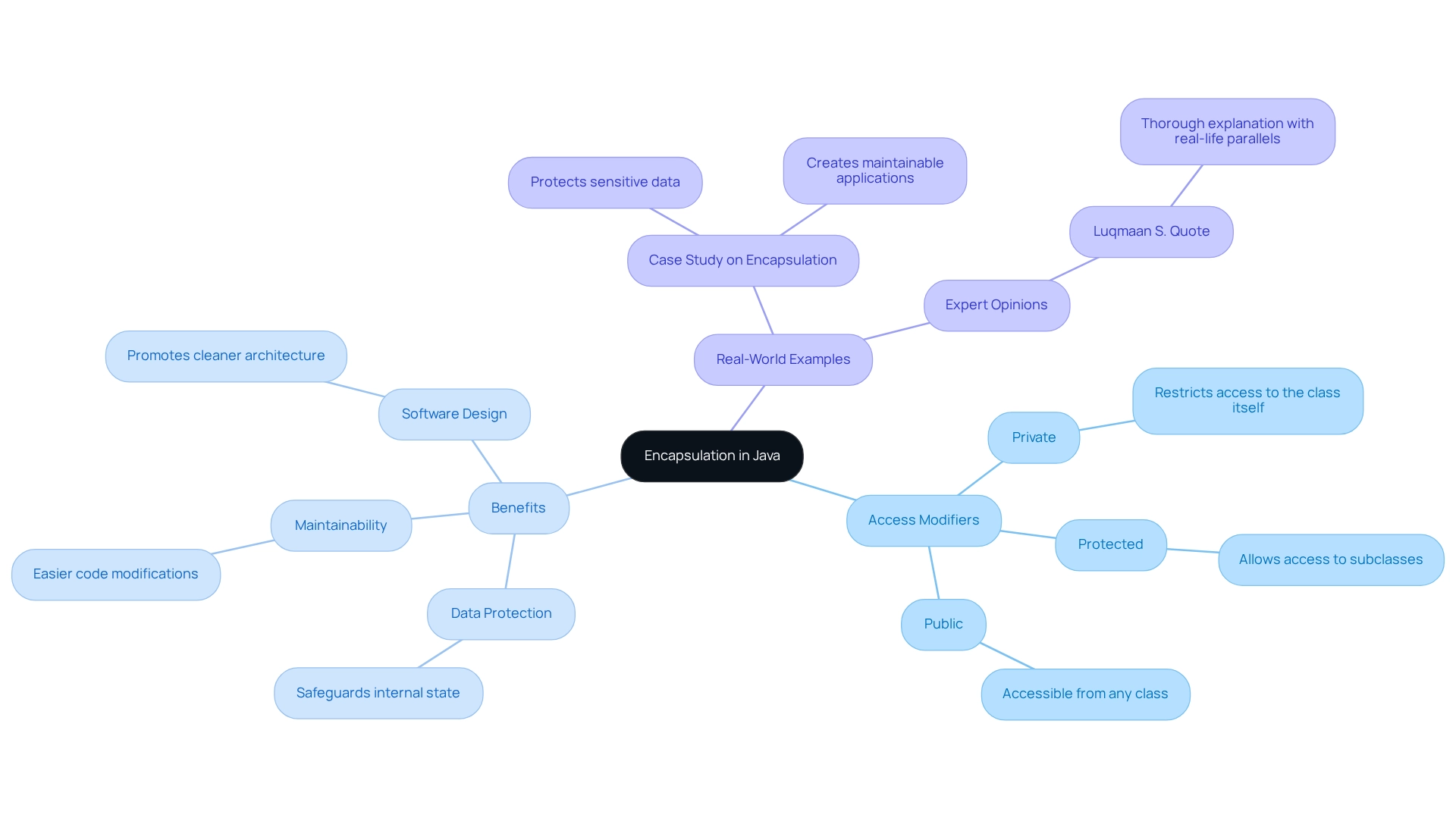
Inheritance in Java: Building on Existing Classes for Reusability
Inheritance is a crucial concept in Java that addresses common coding challenges faced by developers. It allows a new type, or subclass, to inherit properties and methods from an existing type, known as the superclass. This mechanism not only encourages the reuse of programming elements but also enables programmers to enhance existing functionality without the need to rewrite software.
Furthermore, by utilizing inheritance, programmers can establish a hierarchical class structure that streamlines management and improves maintainability. This structure facilitates the implementation of changes and updates, ultimately leading to more efficient coding practices.
Have you ever found yourself rewriting code that already exists? By embracing inheritance, you can significantly reduce redundancy in your projects. This leads to enhanced productivity and higher code quality, making your development process smoother and more efficient.
In addition, inheritance supports a clear organization of code, which is essential for collaborative projects. As you explore the capabilities of inheritance in Java, think about how Java OOP programs can transform your coding approach and contribute to your overall success as a developer.
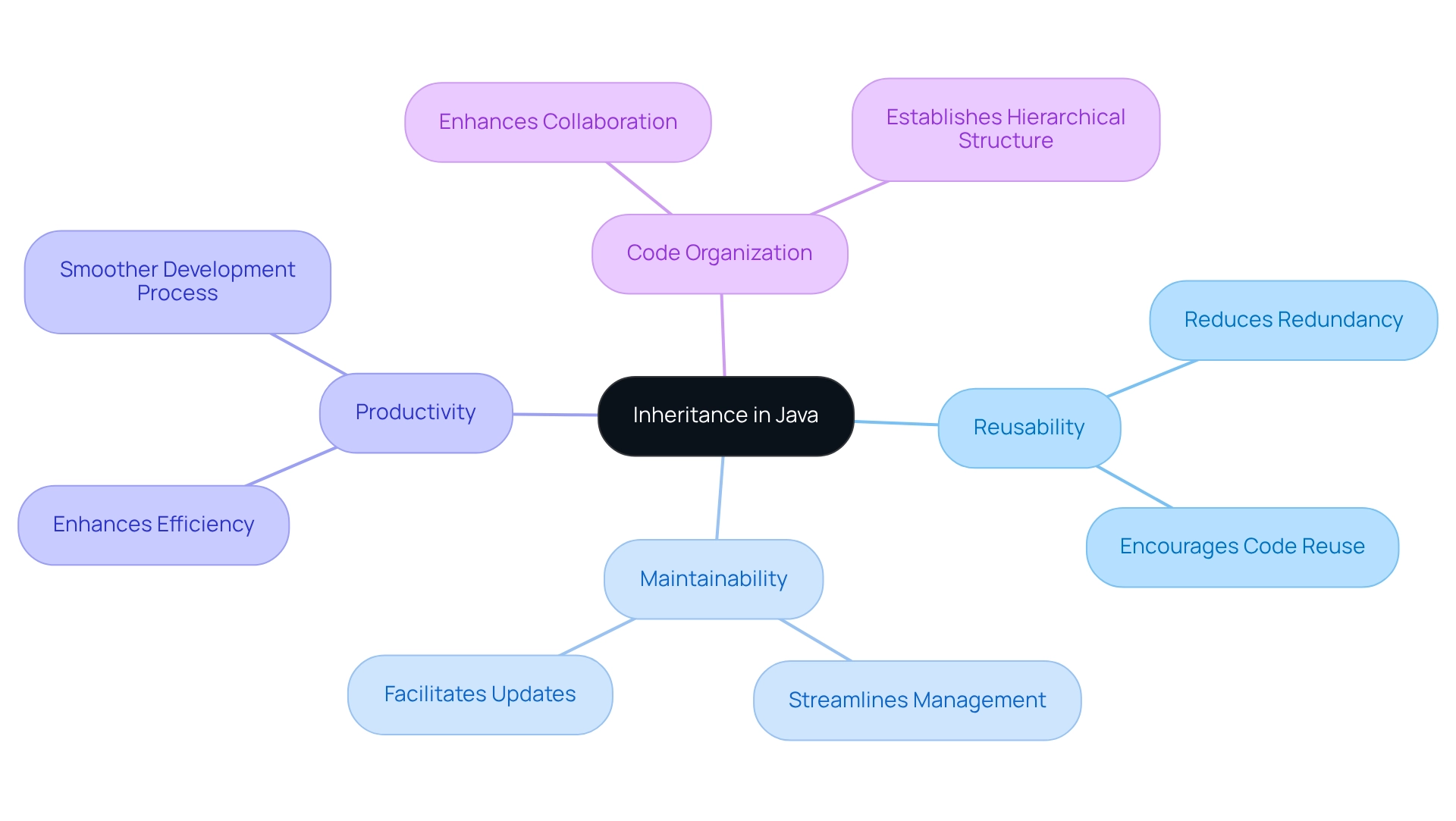
Polymorphism in Java: Achieving Flexibility with Method Overloading and Overriding
Polymorphism in Java presents a compelling solution to the coding challenges developers often face, such as the need for adaptable and efficient code structures. This powerful concept allows methods to be defined in various forms, significantly enhancing programming flexibility and execution. Primarily, this is achieved through two mechanisms: method overloading and method overriding. Method overloading enables programmers to create multiple methods with the same name but different parameter lists, leading to a more intuitive coding experience. Conversely, method overriding allows a subclass to provide a specific implementation of a method previously established in its superclass, fostering reuse and flexibility.
Utilizing polymorphism empowers programmers to create dynamic and reusable structures, adjusting to diverse needs without significant alterations. This flexibility is crucial in modern software development, where the ability to quickly respond to changing requirements can significantly impact project success. Recent statistics indicate that 267 views of related documents have been recorded, showcasing the interest in polymorphism among Java developers to enhance maintainability and efficiency. This underscores the significance of polymorphism in contemporary programming practices.
Furthermore, expert opinions highlight that effective use of polymorphism can lead to cleaner, more organized systems, ultimately improving collaboration among development teams. For instance, David J. Atkinson, a study lead, noted that a fully defined strategy for software reuse and interoperability enhances collaboration by allowing software from diverse sources to integrate predictably. Similarly, a case study on the Bold Stroke avionics software family created by Boeing illustrated how utilizing polymorphism resulted in a 30% decrease in complexity, enabling teams to deliver features more swiftly and with fewer mistakes. As the landscape of software development continues to evolve, the role of polymorphism in ensuring code flexibility remains a cornerstone of efficient programming.
In addition, the introduction of the COSMOS*-VP model aims to specify and implement software variabilities, improving architectural stability and facilitating evolution. This highlights the ongoing relevance of polymorphism in adapting to new challenges, ensuring that developers can maintain a competitive edge in their projects.
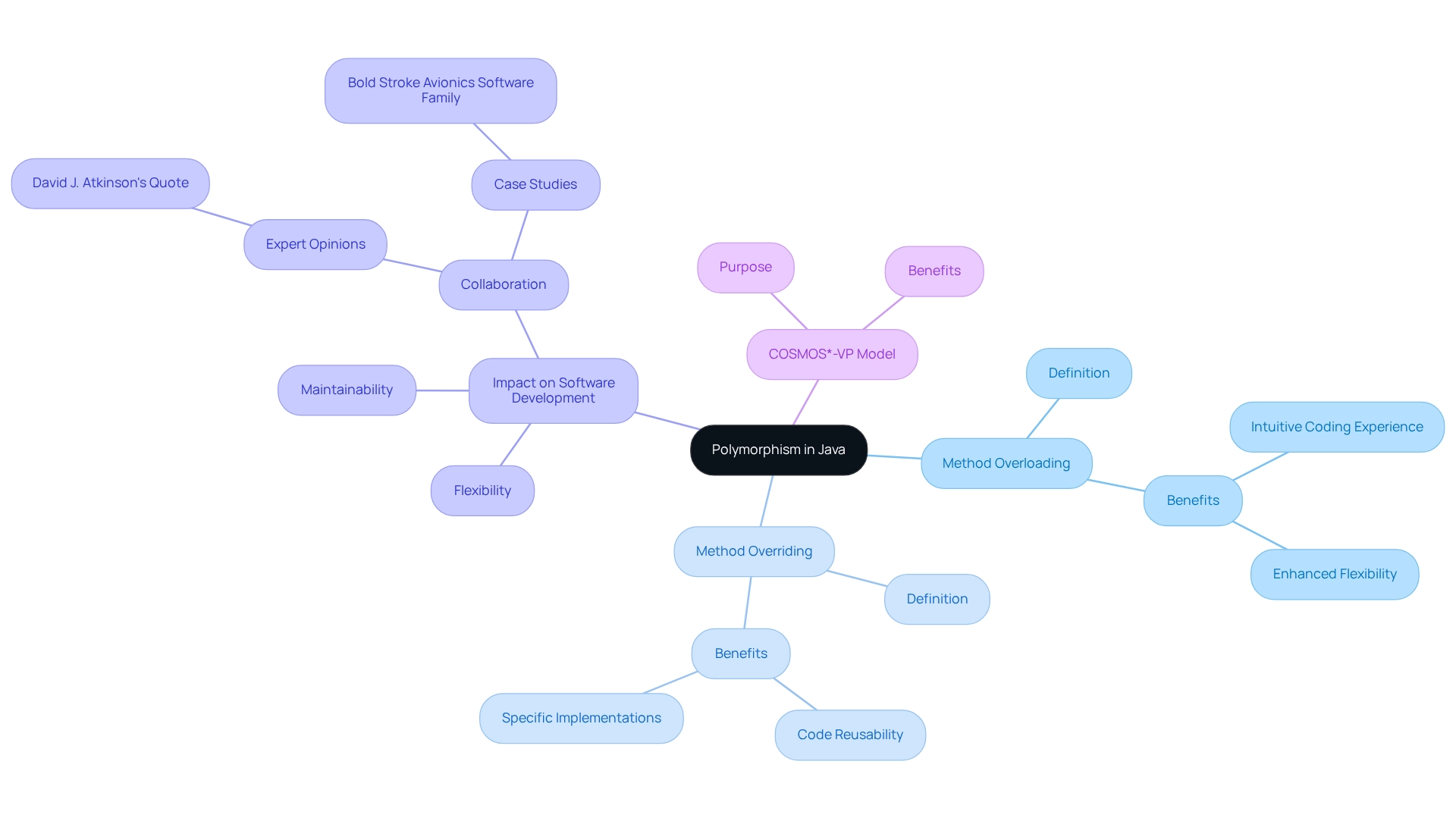
Abstraction in Java: Simplifying Complexity through Abstract Classes and Interfaces
Abstraction in Java is a vital concept that addresses coding challenges developers often face. It is primarily achieved through abstract types and interfaces, allowing programmers to define methods without providing their implementations. This approach creates a blueprint for other classes, focusing on what an object does rather than how it achieves it. By utilizing abstraction, programmers can significantly reduce complexity, enhance reusability, and promote a clear separation of concerns, leading to systems that are easier to maintain and extend.
Statistics show that a substantial portion of Java developers—over 60%—recognize the importance of abstraction in reducing code complexity. This understanding is crucial, as it lays the groundwork for effective software design. For instance, by using abstract types, programmers can establish shared behaviors while delegating specific implementations to subclasses, thereby simplifying the coding process.
Furthermore, expert insights indicate that abstract structures and interfaces not only mitigate complexity but also foster collaboration among development teams. They enable multiple developers to work on different parts of a system without interfering with one another, as the contracts defined by interfaces ensure seamless interaction among all components. As Ragapiriya Rameshkumar notes, the 'abstract' keyword often signifies the unfinished nature of a class or method, emphasizing the importance of understanding abstraction in programming.
A notable case study illustrates the impact of abstraction in Java OOP programs development. Developers transitioning between frameworks found that Kodezi's automatic bug analysis and code correction capabilities allowed them to adapt their code effortlessly, minimizing the need for extensive rewrites. This capability highlights how abstraction can facilitate smoother transitions and enhance overall productivity. Users have praised Kodezi for its ability to expedite bug discovery and resolution, with one user stating, "Kodezi has helped me find and fix bugs faster and easier than trying to manually. It is a lifesaver when it comes to correcting issues and bugs."
In 2025, the emphasis on simplifying complexity through abstraction remains critical, with ongoing discussions in the programming community about best practices for effectively utilizing abstract classes and interfaces. Recent certification training sessions organized by ScholarHat underscore the significance of mastering Java OOP programs and OOP concepts before delving into abstraction, reinforcing the relevance of these principles as the programming field evolves. As one software engineer remarked, "I love what Kodezi is doing with debugging; it feels like I just unlocked a new superpower!" This sentiment reflects the transformative impact Kodezi has on developers' productivity and debugging experiences.
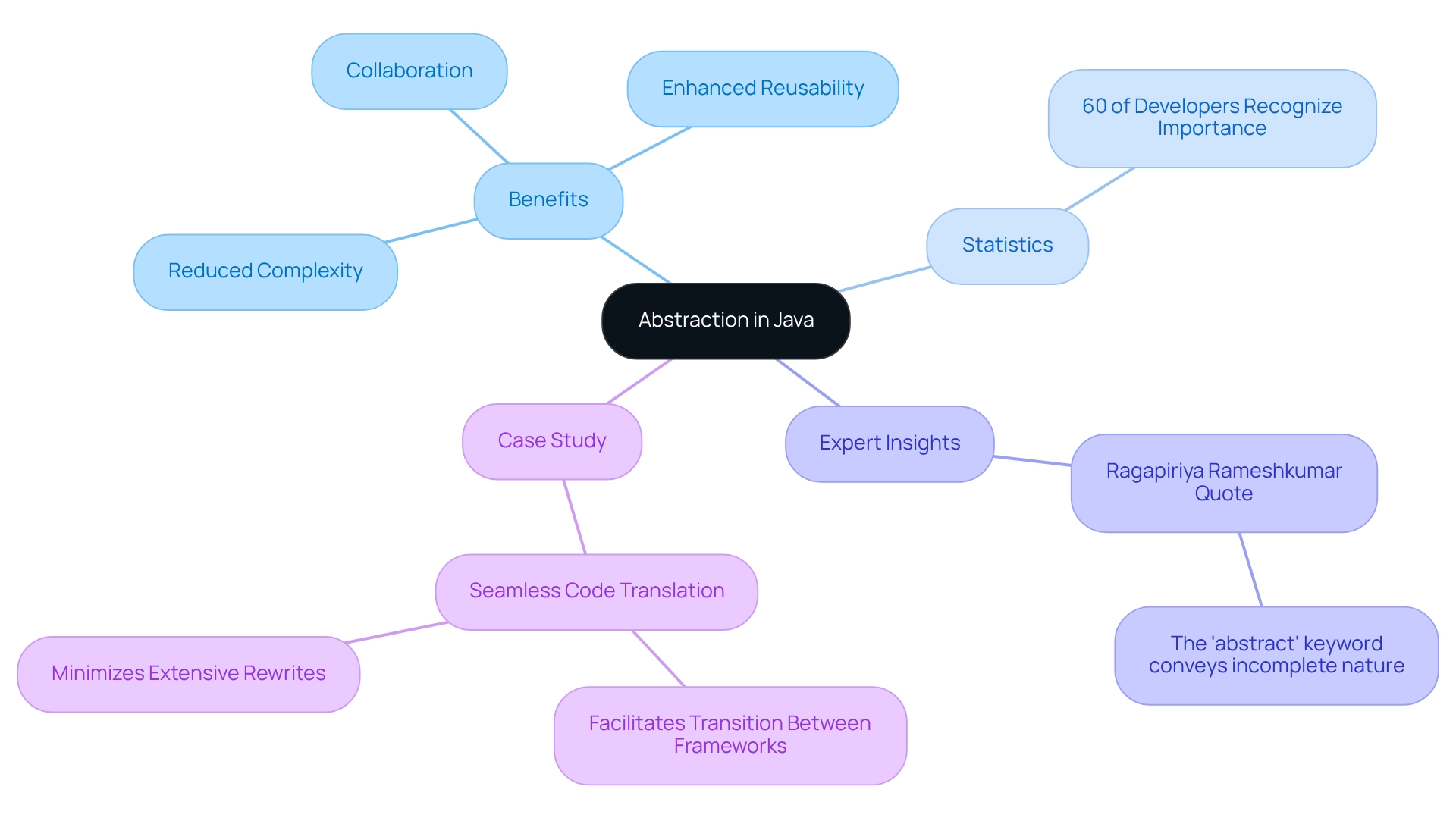
Java Virtual Machine (JVM): The Engine Behind Java OOP Execution
The JVM plays a pivotal role in the coding ecosystem, serving as the engine that executes bytecode and provides a runtime environment.
Have you ever thought about how applications can seamlessly run across different platforms? This is made possible by the JVM, which embodies the 'Write Once, Run Anywhere' principle.
Understanding the intricacies of the JVM, including its memory management and garbage collection processes, is vital for developers aiming to optimize application performance and ensure efficient resource utilization.
By delving into these aspects, developers can significantly enhance their coding practices and productivity.
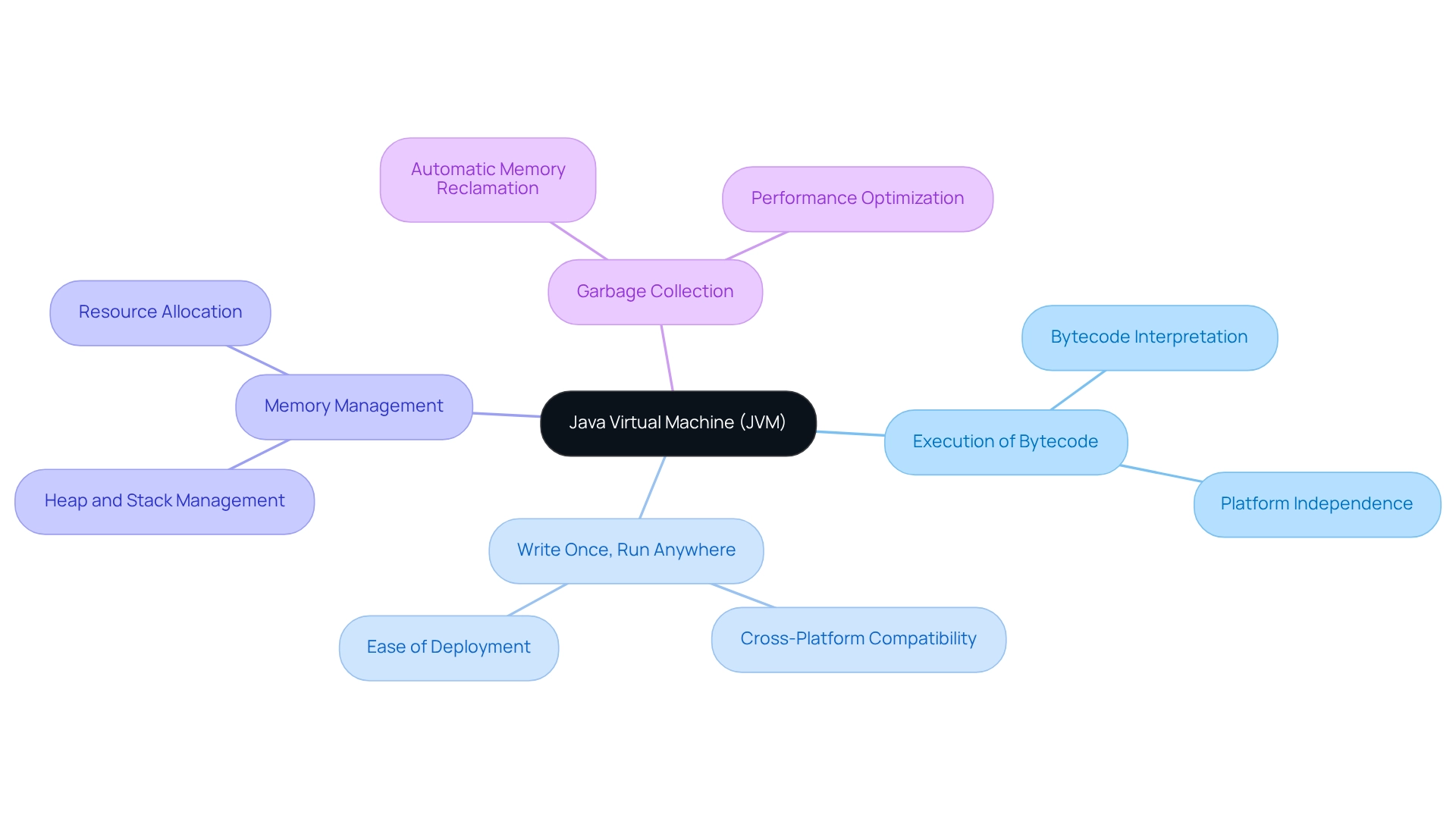
Design Patterns in Java: Leveraging OOP Principles for Effective Solutions
Design patterns in Java serve as standardized solutions to recurring design challenges faced by programmers. By leveraging object-oriented programming (OOP) principles, Java OOP programs implement patterns such as Singleton, Factory, and Observer to establish robust frameworks that aid in developing scalable and maintainable applications. The adoption of design patterns has been shown to enhance code quality and maintainability, with studies indicating that teams utilizing these patterns can reduce development time by as much as 30%. For instance, the Decorator pattern dynamically adds new functionality to an existing object, illustrating the effective application of design patterns.
Furthermore, the effective use of design patterns fosters improved collaboration among team members, as they provide a common language and understanding of system architecture. A notable example is the Circuit Breaker pattern, which Slack employs to significantly enhance their CI/CD pipeline availability, demonstrating how design patterns can directly influence system reliability and user experience. As Martin Thompson noted, "there is a unique opportunity for creators to introduce custom protocols at their system's interaction points," underscoring the flexibility and power of design patterns in meeting specific needs.
However, it is crucial to apply these patterns judiciously; excessive use can complicate programs and lead to maintenance challenges. Thus, understanding when and how to implement design patterns is vital for maximizing their effectiveness. As we move into 2025, the emphasis on utilizing design patterns continues to grow, with programmers increasingly recognizing their significance in crafting effective Java OOP programs to solve common OOP challenges within the language. Moreover, Kodezi exemplifies how design patterns can enhance programmer productivity through automated debugging and optimization, maintaining high standards in software quality. With Kodezi CLI, teams can swiftly auto-heal codebases, ensuring they never waste time on a pull request again. This versatility positions Kodezi CLI as a Swiss-Army Knife for programmers, complementing the implementation of design patterns and further elevating programming productivity.
JUnit: Essential for Testing Your Java OOP Implementations
Developers often face significant challenges when it comes to ensuring their code works as intended. JUnit emerges as a robust framework for unit testing in the programming language, empowering developers to create and run tests that verify program functionality. By offering annotations and assertions, JUnit simplifies the testing process and integrates seamlessly with popular build tools like Maven and Gradle.
Furthermore, implementing JUnit tests not only enhances reliability but also supports test-driven development (TDD). This approach ensures that changes do not introduce new bugs, while existing functionality remains intact. By leveraging JUnit, developers can significantly improve their productivity and code quality, making it an essential tool in their development toolkit.
Automated Code Optimization: Enhancing Java OOP Practices with Advanced Tools
Coding challenges are a common hurdle for developers, often leading to performance issues and security vulnerabilities. Kodezi addresses these challenges by autonomously identifying and resolving performance bottlenecks, security vulnerabilities, and code formatting issues. Its AI-driven capabilities provide developers with instant feedback and detailed insights. This allows them to fix performance bottlenecks, add exception handling, and ensure adherence to the latest security best practices and coding standards.
Furthermore, by integrating automated optimization into the development workflow, teams can leverage Kodezi CLI to enhance programming productivity. This tool not only auto-heals codebases but also ensures that applications are functional, performant, and secure. Imagine the efficiency gains when your code is consistently optimized and adheres to high standards.
In addition, Kodezi empowers developers to focus on what truly matters: writing quality code. With its features, teams can streamline their processes and improve overall code quality. Have you considered how much time you could save by using a tool that enhances your coding practices?
Explore the tools available on the Kodezi platform to transform your development experience and elevate your coding standards.
Conclusion
Mastering Java's Object-Oriented Programming principles—encapsulation, inheritance, polymorphism, and abstraction—is essential for developers facing coding challenges. These foundational concepts not only empower developers to write cleaner, more modular code but also enhance collaboration within teams. Furthermore, tools like Kodezi address common pain points by automating documentation, optimizing code quality, and providing essential features such as the Professional OpenAPI Specification Generator.
The significance of understanding and effectively implementing these OOP principles cannot be overstated. They enhance productivity and ensure that applications are robust and secure. By leveraging Kodezi and its AI-driven capabilities, developers can focus on innovation and creativity rather than being burdened by administrative tasks or code management issues.
As the demand for high-quality software solutions continues to rise, embracing these principles alongside advanced tools will be crucial for any Java developer aiming to excel in their craft. In addition, emphasizing continuous learning and adaptation in the evolving landscape of software development will lead to improved collaboration, increased efficiency, and the successful delivery of top-notch applications. Why not explore the tools available on the Kodezi platform to elevate your coding practices today?
Frequently Asked Questions
What challenges do developers face in maintaining code quality and documentation?
Developers often struggle with maintaining code quality and keeping documentation up to date, which can distract them from focusing on application development.
How does Kodezi assist Java programmers?
Kodezi provides a Professional OpenAPI Specification Generator that automates API documentation production, ensuring it aligns with development changes, allowing developers to concentrate on building robust applications.
What features does Kodezi offer to improve the documentation process?
Kodezi automatically generates OpenAPI specifications and creates a Swagger UI for testing, which enhances programming quality through automated reviews and boosts productivity.
How does Kodezi contribute to codebase maintenance?
Kodezi enables teams to automatically repair codebases and resolve issues before they reach production, improving efficiency by addressing potential problems proactively.
Why is understanding types and objects important in Java OOP?
Mastering types and objects is essential for creating modular and reusable structures in Java OOP programs, significantly enhancing productivity and allowing functionalities to be reused and tailored to user needs.
What is the role of Kodezi CLI in programming?
Kodezi CLI acts as a versatile tool for programmers, allowing teams to auto-heal codebases quickly, enabling them to focus on writing efficient code rather than managing pull requests.
What is encapsulation in Java, and why is it important?
Encapsulation in Java involves using access modifiers to protect an object's internal state from unauthorized access, enhancing security and maintainability by establishing a clear distinction between an object's interface and its implementation.
How do access modifiers contribute to encapsulation?
Access modifiers like private, protected, and public regulate how data is accessed and modified, ensuring that sensitive data is protected and that code can be modified without affecting other components.
What are the broader benefits of encapsulation in software design?
Encapsulation promotes cleaner application architecture, reduces vulnerabilities in software, and makes applications easier to maintain by treating units as black boxes that manage their internal state through controlled access methods.




